Classification
of Matter
Evidence
suggests that substances are made up of smaller particles that are
ordinarily moving around. Some of those particles of matter can be split into
smaller units using fairly strong heat or electricity into smaller rather
uniform bits of matter called atoms. Atoms are the building blocks of
elements. Elements are all those substances that have not ever been
decomposed or separated into any other substances through chemical reactions,
by the application of heat, or by attempting to force an direct
electric current through the sample. Atoms in turn have been found to be made
up of yet smaller units of matter called electrons, protons, and
neutrons.
Elements
can be arranged into what is called the periodic
table of elements based on observed similarities in chemical
and physical properties among the different elements. When atoms of two or more
elements come together and bond, a compound is formed. The compound formed
can later be broken down into the pure substances that originally reacted
to form it.
Compounds
such as water are composed of smaller units of bonded atoms called molecules.
Molecules of a compound are composed of the same proportion of elements as the
compound as a whole since they are the smallest units of that compound.
For example, every portion of a sample of water is composed of water molecules.
Each water molecule contains two hydrogen atoms and one oxygen atom, and so
water as a whole has, in a combined state, twice as many hydrogen atoms as
oxygen atoms..
Water
can still consist of the same molecules, but its physical properties may
change. For instance, water at a temperature below 0° Celsius (32°
Fahrenheit) is ice, whereas water above the temperature of 100° C (212° F)
is a gas, water vapor. When matter changes from one state to another,
temperature and pressure may be involved in the process and the
density and other physical properties change. The temperature and pressure
exerted on a sample of matter determines the resulting form of that the matter
takes, whether solid, liquid, or gas.
Since
the properties of compounds and elements are uniform, they are classified
as substances. When two or more substances are mixed together, the
result is called a mixture. Mixtures can be classified into two main categories:
homogeneous and heterogeneous. A homogeneous mixture is one in
which the composition of its constituents are uniformly mixed throughout. A
homogeneous mixture in which on substance, the solute, dissolves
completely in another substance, the solvent, may also be called a solution. Usually
the solvent is a liquid, however the solute can be either a liquid, solid, or a
gas. In a homogeneous solution, the particles of solute are spread evenly
among the solvent particles and the extremely small particles of
solute cannot be separated from the solvent by filtration through filter
paper because the spaces between paper fibers are much greater than
the size of the solute and solvent particles. Other examples of
homogeneous mixtures include sugar water, which is the mixture of sucrose and
water, and gasoline, which is a mixture of dozens of compounds.
Example 1:
Homogeneous Mixture
Filtered seawater
is solution of the compounds of water, salt (sodium chloride), and other
compounds.
A heterogeneous mixture
is a nonuniform mixture in which the components separate and the composition
varies. Unlike the homogeneous mixture, heterogeneous mixtures can be separated
through physical processes. An example of a physical process used is
filtration, which can easily separate the sand from the water in a sand-water
mixture by using a filter paper. Some more examples of heterogeneous mixtures
include salad dressing, rocks, and oil and water mixtures. Heterogeneous
mixtures involving at least one fluid are also called suspension mixtures and
separate if they are left standing long enough. Consider the idea of mixing oil
and water together. Regardless of the amount of time spent shaking
the two together, eventually oil and water mixtures will separate with the oil
rising to the top of the mixture due to its lower density.
Example 2:
Heterogeneous Mixture
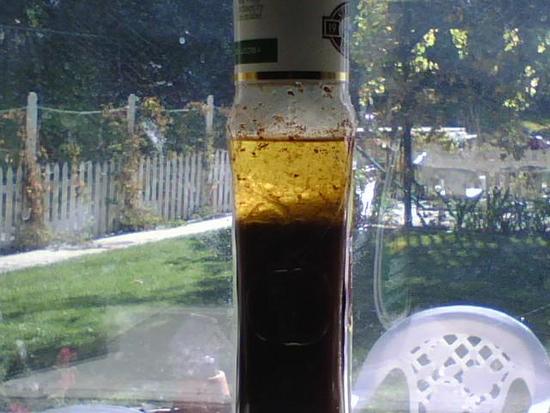
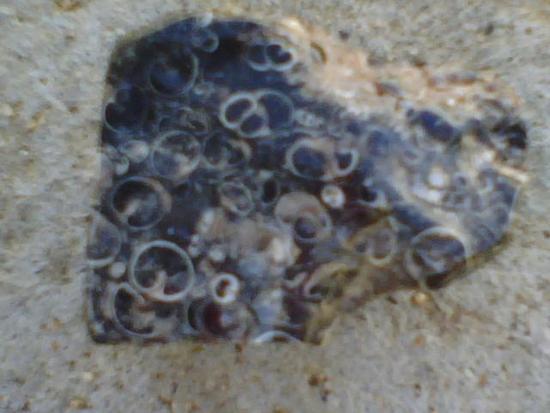
separation
of sand and
water
separation of salad
dressing
various mixtures within a rock
Mixtures
that fall between a solution and a heterogeneous mixture are called colloidal suspensions (or just colloids). A
mixture is considered colloidal if it typically does not spontaneously separate
or settle out as time passes and cannot be completely separated by filtering
through a typical filter paper. It turns out that a mixture is colloidal
in its behavior if one or more of its dimensions of length, width, or
thickness is in the range of 1-1000 nm. A colloidal mixture can also be
recognized by shining a beam of light through the mixture. If the mixture
is colloidal, the beam of light will be partially scattered by the
suspended nanometer sized particles and can be observed by the viewer. This is
known as the Tyndall effect. In the case of the Tyndall
effect, some of the light is scattered since the wavelengths of light in
the visible range, about 400 nm to 700 nm, are encountering suspended colloidal
sized particles of about the same size. In contrast, if the beam of light
were passed through a solution, the observer standing at right angles to the
direction of the beam would see no light being reflected from either the
solute or solvent formula units that make up the solution because the
particles of solute and solvent are so much smaller than the wavelength of the
visible light being directed through the solution.
- Solutions: molecules ~0.1-2 nm in size
- Colloids: molecules ~ 2-1000 nm in size
- Suspensions: molecules greater than ~ 1000 nm in size
Example 3:
Colloidal Mixtures
Colloidal mixture have components
that tend not to settle out.

Milk is a colloid of liquid butterfat globules suspended
in water
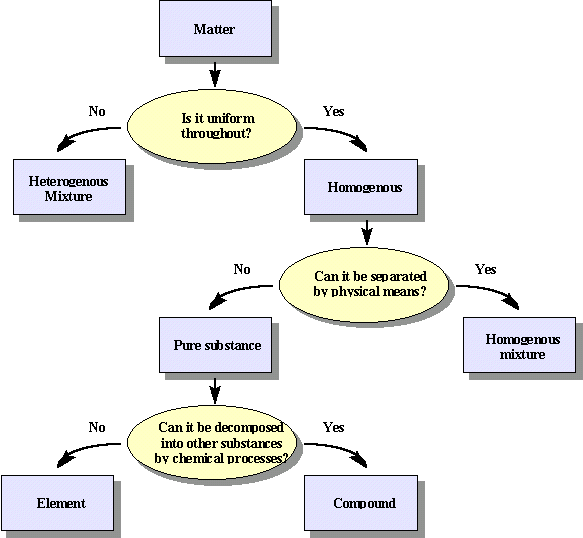
Figure
2: Flow chart for matter breakdown.
Separation of Mixtures
Most
substances are naturally found as mixtures, therefore it is up to the chemist
to separate them into their natural components. One way to remove a substance
is through the physical property of magnetism. For example, separating a
mixture of iron and sulfur could be achieved because pieces of iron would be
attracted to a magnet placed into the mixture, removing the iron from the
remaining sulfur. Filtration is another way to
separate mixtures. Through this process, a solid is separated from a liquid by
passing through a fine pored barrier such as filter paper. Sand and water can
be separated through this process, in which the sand would be trapped behind
the filter paper and the water would strain through. Another example of
filtration would be separating coffee grounds from the liquid coffee through
filter paper. Distillation is
another technique to separate mixtures. By boiling a solution of a non-volatile
solid disolved in a liquid in a flask, vapor from the lower boiling point
solvent can be driven off from the solution by heat,
be condensed back into the liquid phase as it comes in contact
with cooler surfaces, and be collected in another container. Thus a
solution such as this may be separated into its original components, with
the solvent collected in a separate flask and the solute left behind in
the original distillation flask. An example of a solution being separated
through distillation would be the distillation of a solution of copper(II)
sulfate in water, in which the water would be boiled away and collected and the
copper(II) sulfate would remain behind in the disllation flask.

Figure
3: The picture above depicts the
equipment needed for a distillation process. The homogeneous mixture starts out
in the left flask and is boiled. The vapor then travels down chilled tube on
the right and condenses back into a liquid and drips into the flask.
States of Matter
Everything that is familiar to us in
our daily lives - from the land we walk on, to the water we drink and the air
we breathe - is based upon the states of matter called gases,
liquids, and solids.
Solids
When
the temperature of a liquid is lowered to the freezing point
of the substance (for water the freezing point is 0oC), the
movement of the particles slows with the spacing between the particles changing
until the attractions between the particles lock the particles into a solid
form. At the freezing point, the particles are closely packed together and
tend to block the motions of each other. The attractions between the
particles hold the particles tightly together so that the entire
ensemble of particles takes on a fixed shape. The volume of the solid is
constant and the shape of a solid is constant unless deformed by a
sufficiently strong external force. (Solids are thus unlike liquids whose
particles are slightly less attracted to one another because the particles
of a liquid are a bit further apart than those in the corresponding solid form
of the same substance.) In a solid the particles remain in a relatively
fixed positions but continue to vibrate. The vibrating particles in
a solid do not completely stop moving and can slowly move into any voids that
exist within the solid.
Figure
4: The diagram on the
left represents a solid whose constituent particles are arranged in an
orderly array, a crystal lattice. The image on the right is a ice cube. It has
changed from liquid into a solid as a result of absorbing energy from its
warmer environment.
Liquids
When
the temperature of a sample increases above the melting point of a
solid, that sample can be found in the liquid state of matter. The
particles in the liquid state are much closer together than those in the
gaseous state, and still have a quite an attraction for
each other as is apparent when droplets of liquid form. In this
state, the weak attractive forces within the liquid are unable to hold the
particles into a mass with a definite shape. Thus a liquid's shape takes
on the shape of any particular container that holds it. A
liquid has a definite volume but not a definite shape. Compared to to the
gaseous state there is less freedom of particle movement in the liquid
state since the moving particles frequently are colliding with one another, and
slip and slide over one another as a result of the attractive forces that still
exist between the particles, and hold the particles of the liquid loosely
together. At a given temperature the volume of the liquid is
constant and its volume typically only varies slightly with changes in
temperature.
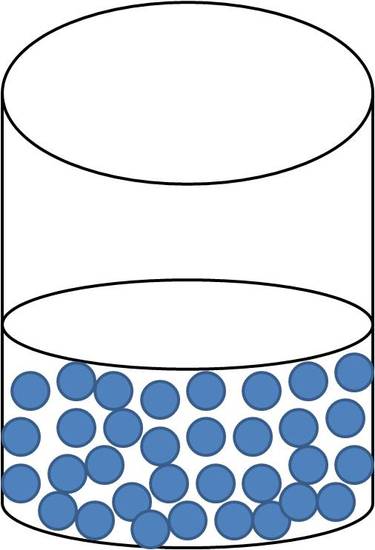
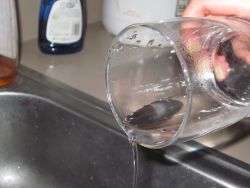
Figure
5: The diagram on the
left represents a container partially filled with a liquid. The image
on the right is of water being poured out of a glass. This shows that liquid
water has no particular shape of its own.
Gases
In
the gas phase, matter does not have a fixed volume or shape. This occurs
because the molecules are widely separated with the spaces between the
particles typically around ten times further apart in all three spatial
directions, making the gas around 1000 times less dense than the corresponding
liquid phase at the same temperature. (A phase is a uniform portion of
mater.) As the temperature of a gas is increased, the particles to
separate further from each other and move at faster speeds. The particles
in a gas move in a rather random and independent fashion, bouncing
off each other and the walls of the container. Being so far apart from
one another, the particles of a real gas only weakly attract each other such
that the gas has no ability to have a shape of its own. The extremely weak
forces acting between the particles in a gas and the greater amount of space
for the particles to move in results in almost independent motion of the
moving, colliding particles. The particles freely range within any
container in which they are put, filling its entire volume with the net result
that the sides of the container determine the shape and volume of
gas. If the container has an opening, the particles heading in the direction of
the opening will escape with the result that the gas as a whole slowly flows
out of the container.
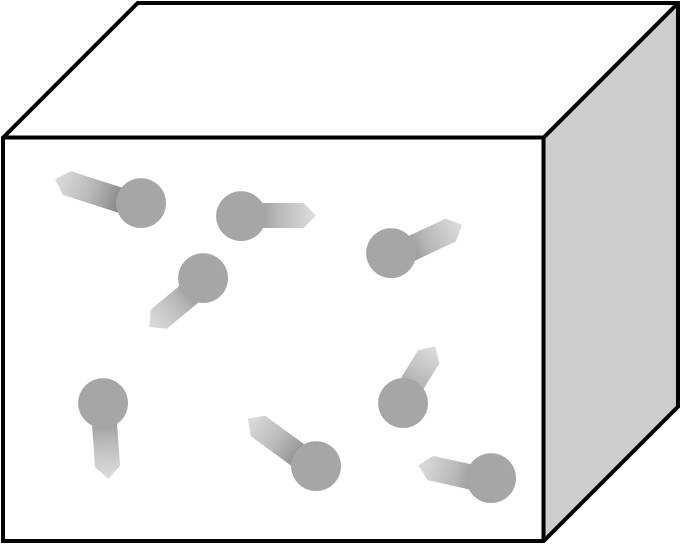

Figure
6: The image on the
left represents an enclosed container filled with gas. The images are
meant to suggest that the gas particles in the container are moving
freely and randomly in myriad directions.The image on the right shows
condensing water forming from the water vapor that escaped from the
container.
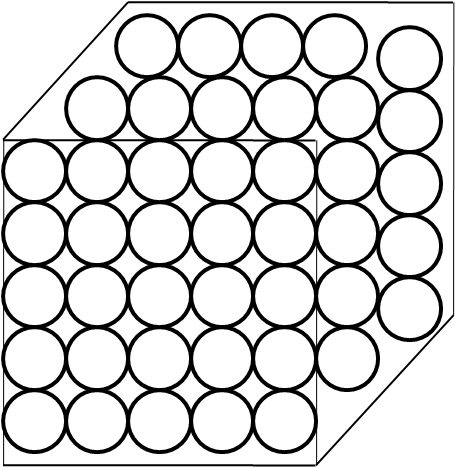



hi Elta, your blog look so awesome, so what the summary of your post?
BalasHapusBesides of the three classical states of matter, there are many other states of matter that share characteristics of one more of the classical states of matter. Most of these states of matter can be put into three categories according to the degrees in varying temperature. At room temperature, the states of matters include liquid crystal, amorphous solid, and magnetically ordered states. At low temperatures the states of matter include superconductors, superfluids, and Bose-Einstein condensate state of matter. At high temperatures the states of matter include, plasma and Quark-gluon plasma. These other states of matter are not typically studied in general chemistry.
HapusHi Elta. could you give me example for gas, liquid, and solid?
BalasHapusoke rahmi i wil ask you about quastion
HapusSolid to Liquid: Melt / Melt
The change of being from solid to liquid.
Example :
Ice melting stone.
Wax melts exposed to fire.
Liquid to Solid: Freeze
The change of being from a liquid to a solid.
Example :
Frozen water in the refrigerator (freezer).
The frozen candle by itself.
Gas to Liquid: Condensate
The transformation of a gas object into a liquid.
Example :
Dew on the plant in the morning.
hi elta, could you tell me the spesificly different of molecule and compound?
BalasHapus
HapusMolecules are formed when two or more atoms join together chemically. While the compound is a molecule containing at least two different elements. All compounds are molecules but not all molecules are compounds.
I would like to ask, on what terms can be a compound of an element?
BalasHapusPlease explain.
Komentar ini telah dihapus oleh pengarang.
HapusA. The compound may be formed by a process of a chemical reaction
HapusB. The constituent components present in a compound must have a certain ratio of a fixed nature.
C. The compound will not be separated by its constituent components back by a physical reaction.
D. The compound can be categorized as a single substance compound.
E. Has certain properties that are different from the constituent elements. Comparison of two hydrogens and one oxygen.
Would you please give an example of a homogeneous mixture of solids.
BalasHapus
Hapusexample Solids with solids, such as sugar with coffee
Hallo elta, Between water and alcohol are interconnected nature dissolves. What is the purpose of the statement?
BalasHapusThe nature of alcohol can be seen from two aspects, the physical properties of alcohol and the chemical properties of alcohol (alcohol reactions). Physical properties of alcohols eg boiling point of alcohol. While the chemical properties of alcohol discuss much about alcohol reactions.
HapusHeterogeneous mixes can be separated by physical processes, how?
BalasHapus
HapusFor the process of separating a heterogeneous mixture there are four main principles of separation process:
Sedimentation
Flotation
Centrifugation
Filtration
The process of separating a homogeneous mixture, in principle, is the separation of the formation of a new phase so that the mixture becomes a heterogeneous mixture that is easily separated. New phase occurs / formed from the differences in physical and chemical properties of each component. A variety of seven methods are used for the occurrence of a new phase so that the homogeneous mixture can be separated
Absorption
Adsorption
Chromatography
Crystallization
Distillation
Evaporation
Electrophoresis
Extraction
Why the solvent is generally liquid?
BalasHapusKomentar ini telah dihapus oleh pengarang.
Hapus
HapusIn chemistry, the solution is a homogeneous mixture consisting of two or more substances. Substances that are fewer in solution are called soluble substances or solutes, while substances that are more numerous than other substances in solution are called solvents or solvents. The solute and solvent composition in solution is expressed in solution concentration, while the process of mixing solutes and solvents to form a solution is called dissolution or solvation.
Examples of common solutions are solids dissolved in liquids, such as salt or sugar dissolved in water. Gases can also be dissolved in liquids, such as carbon dioxide or oxygen in water. In addition, the liquid can also dissolve in other liquids, while the gas dissolves in other gases. There are also solid solutions, such as alloys (metal alloys) and certain mineral
Based on your article on heterogeneous mixtures consisting of several examples of heterogeneous mixtures including salad dressing, rocks, and a mixture of oil and water. How is the separation?
BalasHapusWe must separate it from the mixture. The principle of separation of the mixture is based on differences in physical properties of its constituents, such as the form of matter, particle size, melting point, boiling point, magnetic properties, solubility, and so forth. The following are some methods of separating the mixture.
HapusHow to write the compound chemical formula?
BalasHapus
HapusIn the chemical formula a compound is listed the atomic emblems of the elements that make up the compound, and each elemental symbol is followed by a number indicating the number of atoms of that element in a molecule of the compound.
Why is Milk said colloid of liquid fat clogged in water?
BalasHapusThe colloidal system of a liquid dispersed in a liquid is called an emulsion. The requirement of these emulsions is that the two liquids do not dissolve. Emulsions can be classified into two parts, namely oil-in-water emulsions or water-in-oil emulsions.
Hapus